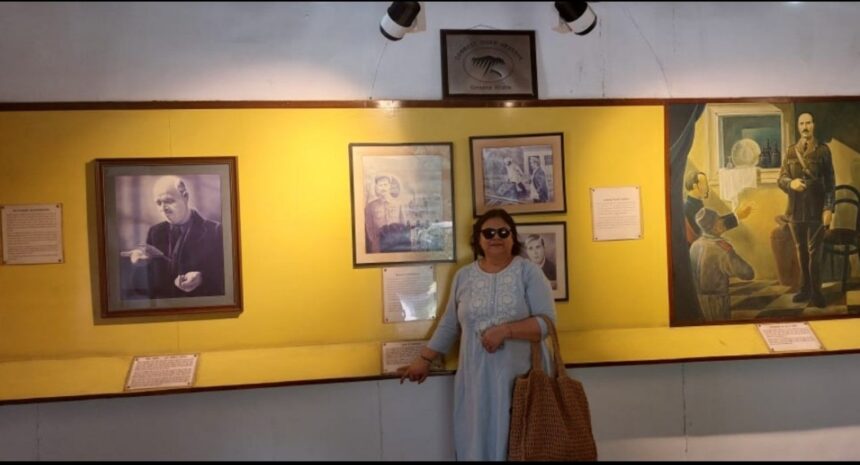Repository of Time & Wilderness : Jim Corbett National Museum, Kaladhungi
“The book of nature has no beginning, as it has no end” —Jim Corbett

By Colonel Satish Singh Lalotra
TRAVELOGUE
As humans, nature always surrounds us. We interact with it now and then. The bio-sphere is the most crucial part of nature regarding the man-nature relationship. Without nature, human beings can’t live normal lives. Nature can be seen as beautiful and harmonious but it also inspires fear in man who has to fight it in order to survive. Now nature is threatened by man who has become detached from it. Technology has endowed humans with the power of a major geological agency , which may act on a continental or even planetary scale for example –acid rain, photochemical smog, radioactive contamination, stratospheric ozone depletion climate change and so on.
It is precisely due to the above mentioned human induced activities that propelled a visionary like Jim Corbett a century back to look upon forests as a repository of human survival. At a time when the forests were looked upon as a source of revenue, visionaries like Jim Corbett, F.W Champion, E.A Symthies, Sir Malcom Hailey, and Lord Linlithgow (Viceroy of India) were the ‘Standard bearers of preservation as well as propagation’ of noble idea of forest conservation with its attendant flora and fauna. Hence germinated the idea of putting the idea of forest conservation on to ground; and out came the famous CTR (Corbett tiger reserve).
Our personal visit to the famous museum of national importance known by the name –‘Jim Corbett National Museum’ was nothing short of a transformative experience, immersing me and my better half in the rich tapestry of India’s rich natural heritage and the remarkable life of legendry hunter of the sub-continent; the irresistible Jim Corbett who had an additional moniker going by the name of ‘Carpet sahib’ attached to him by lakhs of Kumaoni and Garhwali people. To the uninitiated, one should not get confused by the famous Jim Corbett tiger reserve or national park located near Ramnagar with that of Jim Corbett national museum located at Kaladhungi.
Both are separate entities divided by time and space as also by the theme behind formulation of these national icons. The former is on Ramnagar—Kotdwar- Rajaji tiger reserve axis, whereas the latter is located astride Rampur—Bazpur—Kaladhungi—Nainital axis, and is famously called by its colloquial name ‘Chhoti Haldwani’. This colloquial name was bestowed upon the place by Jim Corbett himself as an ode and remembrance for the site and unqualified love showered by the local Kumaonis during his stay over there. It was here that the legendary hunter cum conservator was born and brought up by his British parents.
Since it was the month of May with summer vacations around the corner in my wife’s school, a quick itinerary was made this year with a brief visit to this national icon at Chhoti Haldwani too thrown in to add a dash of nature and wilderness to our travel plans. Since my in-law’s farm at Bazpur was just about 35 minutes driving time to this excellent place astride the road axis as mentioned earlier, not much of preparations were made as a precursor to this museum’s visit. Nestled in the serene hills of Kaladhungi, amidst the lush greenery and untamed wilderness, lies the famous Jim Corbett national museum –a sanctuary not just for wildlife but also for the preservation of history and the legacy of a legendary conservationist.
The museum is located exactly on the cross roads leading to Nainital and the other straight to Almora /Haldwani approaching as it is from Delhi/ Bazpur direction. To a road traveller it is advised to slow down near this junction, lest one may miss this iconic place by the innocuous looking façade of the entrance of this museum that opens up directly on to the highway. The museum has two entrances, with the bigger one reserved for any passage of VIP vehicles that has a semi-circular yellow colored board with broad capital words of national museum of Jim Corbett welcoming you, with the second gate reserved for pedestrians visiting this museum. We both made our way through this second gate where we were greeted by a gentleman of ‘Utrakhand tourism’ who was giving entrance tickets on a nominal payment t of Rupees 100/ each per head.
Having gained our entrance via these tickets we walked about 100 yards leading to a green coloured roofed Irish/ colonial styled cottage with the large sized bust of the legendary hunter Jim Corbett installed on the verandah welcoming us. This was the main building cum residence of the legendary hunter-conservator where he happened to spend the formative years of his existence in India. Don’t expect a grand building, because this structure though quaint looking houses a remarkable collection of Jim Corbett’s personal belongings, artifacts, and memorabilia. Visitors can have a look at Jim Corbett’s old collection of books, letters, and photographs from his hunting days as also his famous hunting equipment. The main hall of this quaint looking cottage of yore has been housing a veritable hue of huge life sized photographs of the hunter with his associates as also an excellent photo of his as an army officer (Lt Col) with the British army.
In addition to the above the hunter has been shown photographed in front of a railway coach and engine belonging to the BNWR ( Bengal & North western railways) as a temporary fuel inspector and was posted first to Bakhtiyarpur , Samstipur and finally to Mokhama Ghat in Bihar from 1892 till 1914. As If this was not enough, he later on served with the British army and fought in the first WW too, thus engraving his chequered career with yet another achievement that is unsurpassable till date by any other hunter –conservator till date. The main hall depicts his photo with his bosom friend cum guide Sardar khan and Kunwar Singh with all in its splendour .The museum has many hallways that have all the qualities of transporting a visitor across various time zones interspersed with the myriad activities that the legendry hunter undertook which most of the times were typical SOS calls from the state or district administrators to alleviate the local villagers from the scourge of man –eating tigers and leopards of Kumaon and Garhwal regions.
Of particular interest a visitor would have is inthe various camp equipment to include camp chairs, camp cots, tables and the elephant Haudi (carriage) of teak wood that the hunter would ride in pursuit of a rampaging man –eater tiger. The museums exhibits are a treasure trove, each telling a compelling story of Corbett’s life and his deep connection with the wilderness. One cannot help but be captivated by the accounts of his thrilling encounters with man-eating tigers and leopards, immortalized through his writings and the displays within the museum.
One of the high lights of our visit was the interactive displays that offered insights into the legendary hunter’s various methods of tacking and conserving wildlife. From his meticulously kept journals to the tools of his trade, every artifact spoke volumes about his dedication and passion for protecting the natural world. Walking through the various hallways of the museum we felt a sense of reverence for the landscapes that Corbett roamed and the creatures he sought to safeguard. The exhibits not only shed light on his humongous efforts towards his conservation efforts but also underscored the need to protect the wild life and the jungles which are so fast receding from our planet. Beyond Corbett’s legacy, the museum also serves as a gateway to the bio-diversity of the region. Detailed exhibits on flora and fauna provide a glimpse into the intricate web of life that thrives in these forests, reminding visitors of the fragility and resilience of the natural world.
In addition to the main cottage devoted to the hunter –conservator, the Uttrakhand government by way of a self-help group of ‘Chhoti-Haldwani’ has opened a souvenir shop in the same precincts that goes by the name of ‘Moti Souvenir shop’. Provided by ‘Corbett tiger reserve, Ramnagar (Nainital) and organized by Corbett Gram vikassamiti , Chhoti Haldwani, the place buzzes with an array of homemade jams, pickles, artifacts, T-Shirts, mufflers, key chains, hats, sola topee and books et.al with Corbett tiger reserve emblems engraved all over the items.
Being an aficionado of nature conservation and books devoted for the subject, my eyes fell on the latest edition of ‘The Corbett story—unfolding the tiger reserve’. With the foreword written by none other than the redoubtable Dr Karan Singh, scion of royal family of Jammu and Kashmir as also the chairman of ‘Indian board for wild life (IBWL), this marvelous book by Anjali Bharathari is a virtual takeaway for an avid naturalist. The same was bought by me for Rs 2500/- as a reminder to me for my brief sojourn with the jungle museum. Since Dr Karan Singh was also the main protagonist for the world famous ‘Project Tiger ’is it any wonder that such books will not find its place of pride in a museum like Jim Corbett , the last word on tiger conservation?
As I concluded my visit, I couldn’t help but reflect on the profound impact that Jim Corbett’s legacy continues to have on conservation efforts worldwide. His ethos of respect for nature and commitment to preservation serve as a guiding light for future generations, inspiring us to tread lightly on this planet and protect its wondrous inhabitants.
In the tranquil surroundings of Kaladhungi amidst the whispers of the forest and the rustle of leaves, the Jim Corbett national museum stands as a testament to the enduring bond between man and nature that has to be on the list of ‘Must visit’ on the itinerary of a visitor this side of Suez canal.
(The writer is a regular scribe of RK and can be approached on his email: slalotra 4729@gmail.com)




